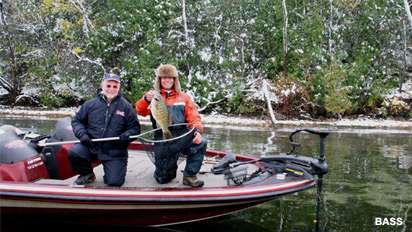
“Some of the best products available for winter survival and comfort are made and marketed for campers, skiers and hikers. Anglers should shop in those departments at their local sporting goods store if they want the newest and the best.”
Keeping warm in cold weather is an absolute necessity if you’re going to have a good time. In Part 1 we looked at headgear. Now we’ll consider the extremities — hands and feet.
Hands
Keeping your hands and fingers dry and warm can be a difficult endeavor. Sam Coalson, hunting and outdoor marketing manager for Rocky Boots (www.rockyboots.com), offers these tips to make that challenge a little less difficult.
1. Staying dry is a must. “It’s important that you stay dry to stay warm. Gore-Tex is one of the best waterproofing materials around, but there are others that work very well in gloves. We offer several styles of gloves that are truly waterproof and that will keep anglers’ hands dry.”
2. Insulate properly. “How much insulation you need depends upon your body’s metabolism, your body movement and the ambient air temperature. Depending upon those factors, we recommend Thinsulate at between 40 and 100 grams in our gloves.”
Note that he doesn’t say hand movement, he says body movement. It’s whole body movement that warms your hands.
Along with those two basics it’s important that your gloves fit properly. If they’re too tight they’ll reduce circulation in your hands. If they’re too loose they’ll let moisture and cold air slip between the fabric and your hands. They should fit snugly but allow for plenty of movement.
If you use chemical heat packs, put them across the backs of your hands. This is where the blood is closest to the surface, and it’s where they’ll do the most good.
Footwear
According to Chris Lorenzo, brand manager for Rocky Boots, these are the things you should keep in mind when buying a pair of outdoor boots:
1. Staying dry is a must. (Yes, I know you’ve heard that before, but it’s worth repeating. If you’re wet you won’t be warm.) “For boots, Gore-Tex is the best waterproofing material available. We strongly recommend it for high-quality footwear.”
2. Insulate properly. “Choose Thinsulate insulation and remember that your body’s metabolism, your body movement and the ambient air temperature all combine to affect your choice of footwear just like it does with gloves. Depending upon those factors we recommend anywhere between 600 and 1400 grams of Thinsulate in our boots.
3. Socks are important. “Choose fabrics that wick away moisture. If necessary wear thin liners underneath heavier socks. Do not allow body moisture to dampen your feet.”
Don’t wear cotton. It’ll hold moisture against your skin.
4. Buy late in the day. “Your feet swell as the day goes along. Buy shoes and boots at the end of the day for a proper fit.”
Outdoors expert, Pat McHugh (www.mpioutdoors.com), offers two more tips to help you select footwear that’ll do the job:
5. Don’t rely on standard sizes. Each brand and model is a little different — sometimes there’s a difference between two pairs of seemingly identical shoes or boots. Quality footwear is expensive; make sure it fits before you buy it.
6. Don’t buy at the last minute. New boots, even good ones, can be tough on your feet. Break them in before your big trip.
Choosing the right gloves or boots isn’t all that difficult if you make sure they fit, make sure they’re waterproof and make sure they’re properly insulated.




